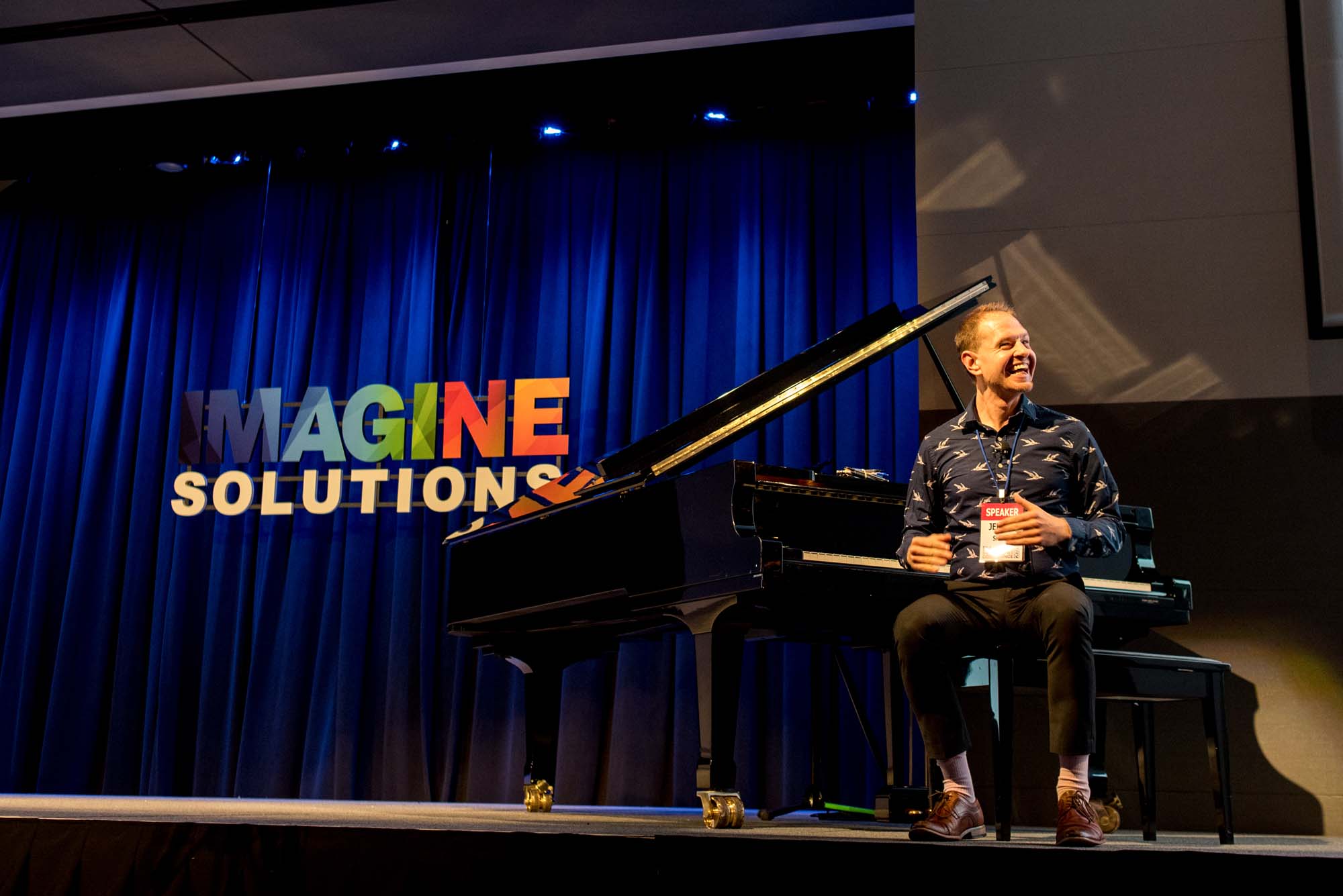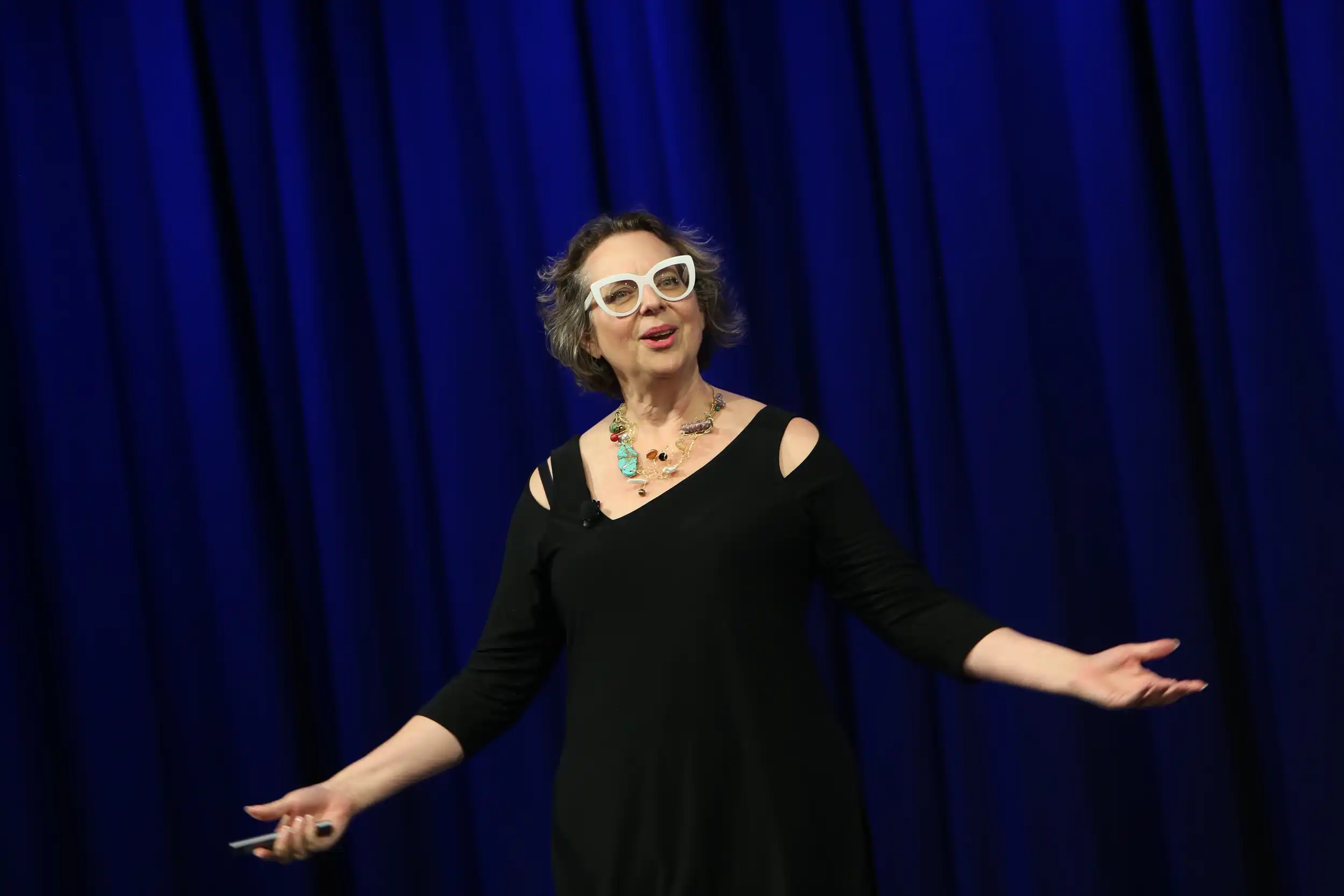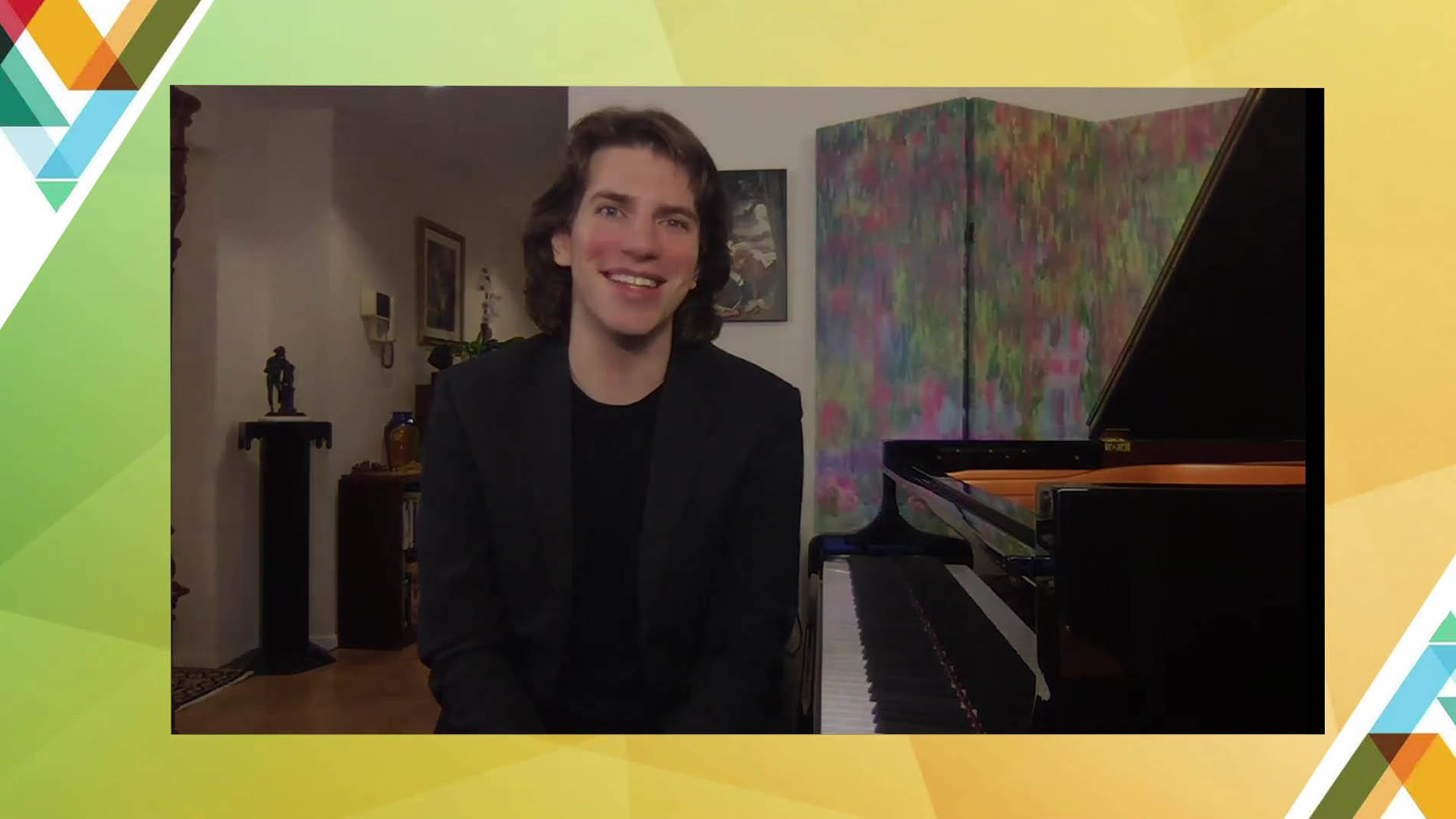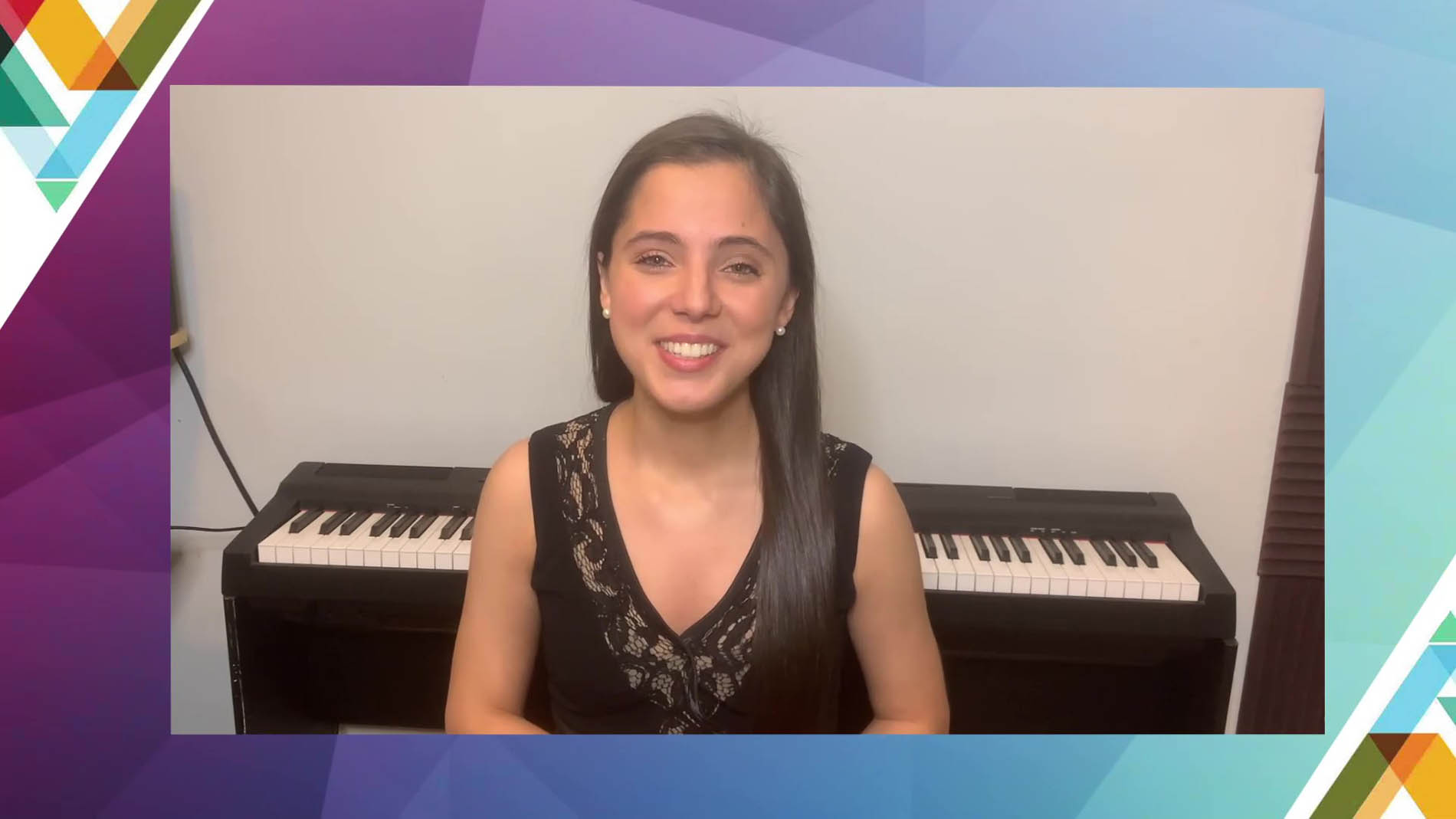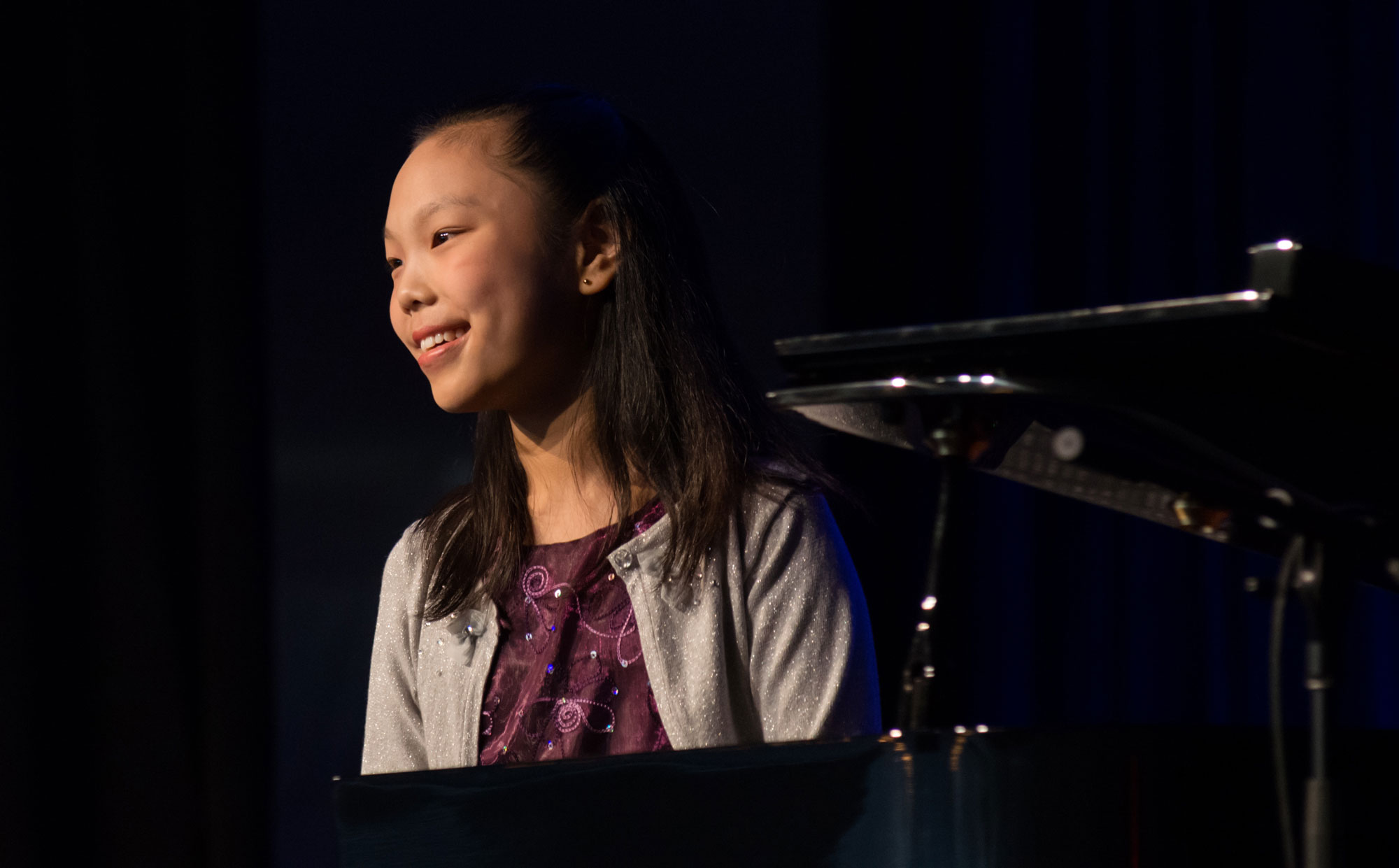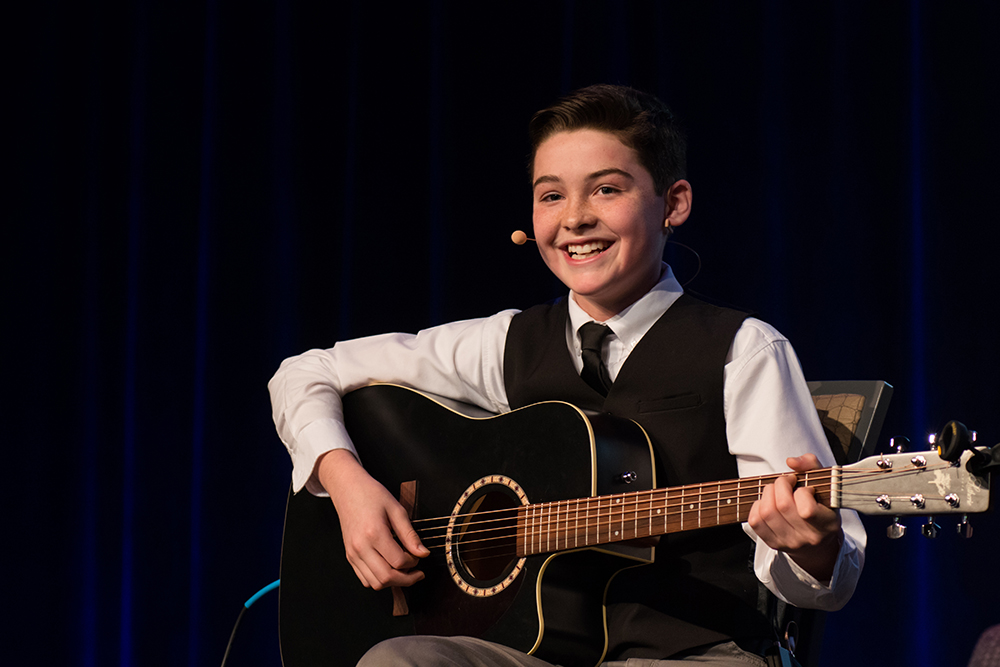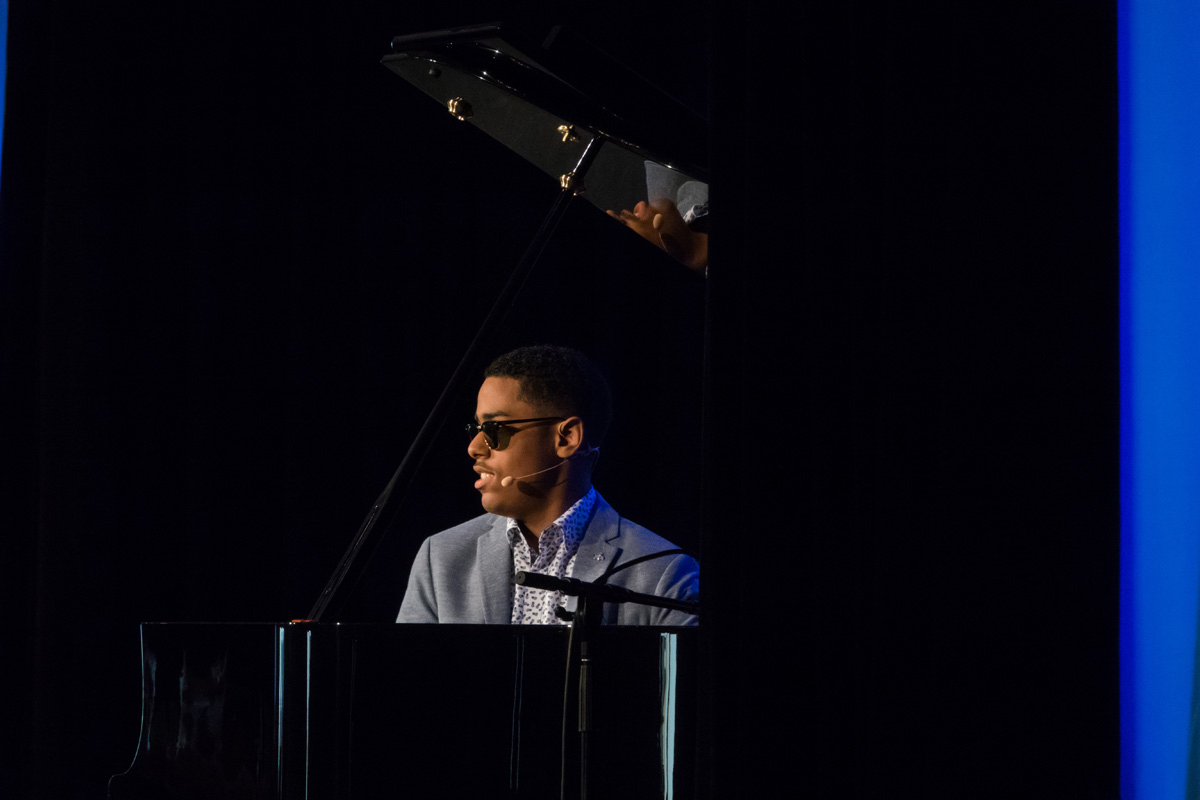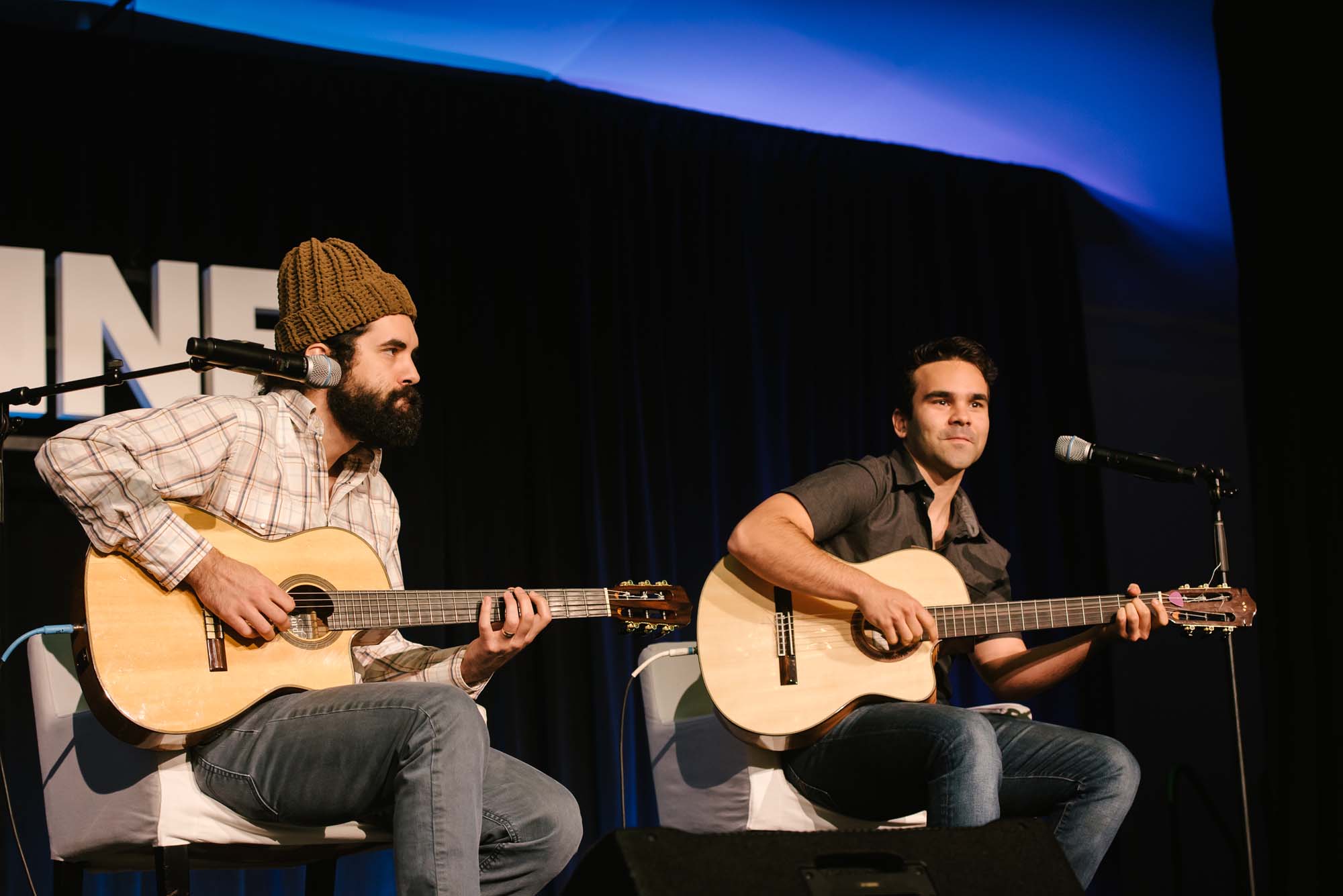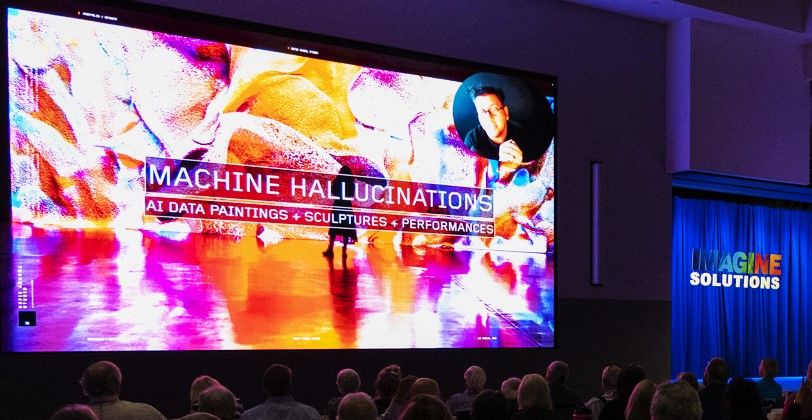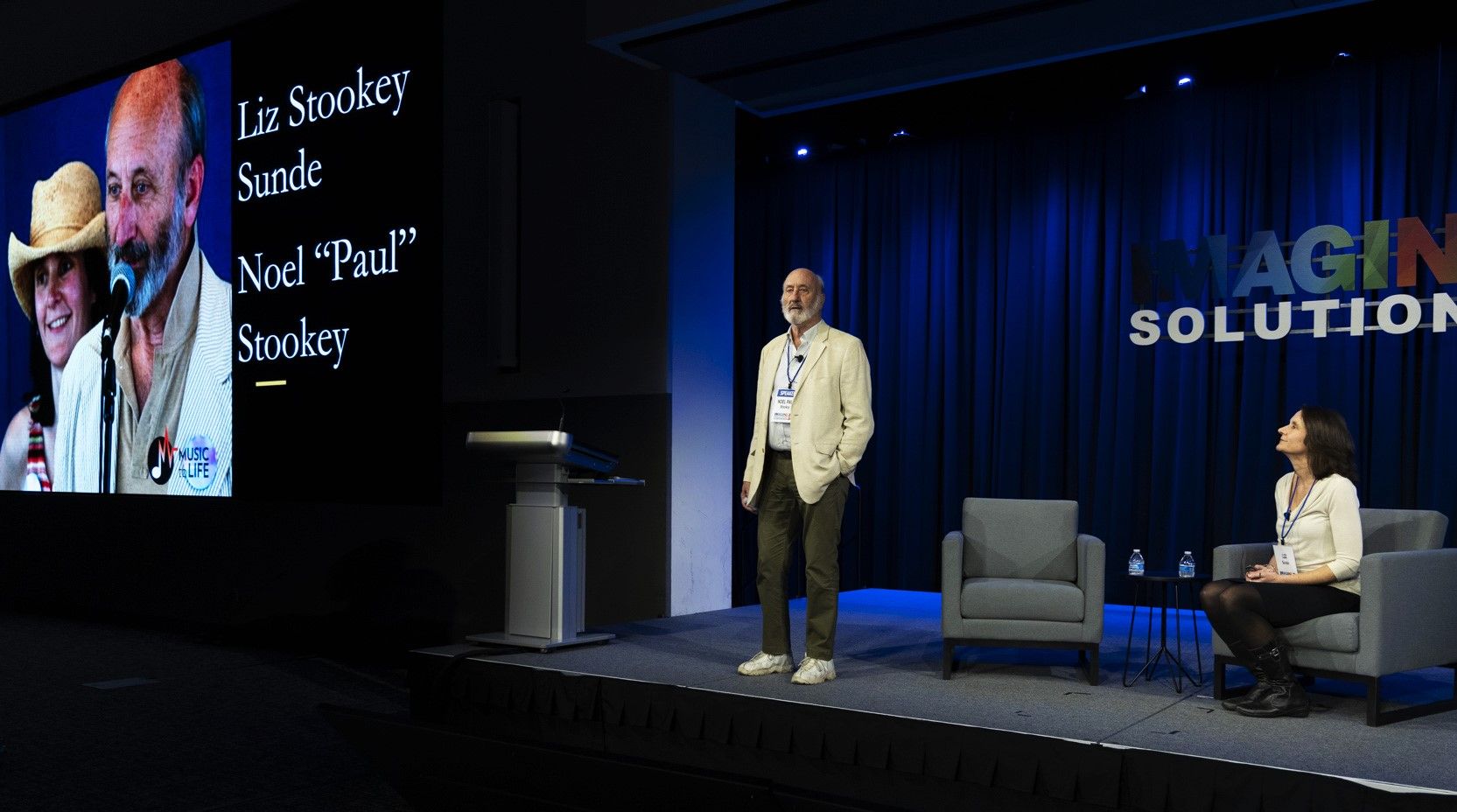The Arts – Jeremy Siskind
Jeremy Siskind is an American pianist, composer, and educator known for his innovative blending of jazz and classical music. Siskind is recognized as a visionary in the areas of ragtime and honky tonk piano. A top finisher in several national and international jazz piano competitions, Siskind is a two-time laureate of the American Pianists Association.
00.26
[Applause] [Music] thank you you're going to hear now from a Pianist
01.01
extraordinaire Jeremy siskin he is a virtuoso a composer and an educator known for his Innovative blending of jazz and classical music I invite you to sit back be entertained and listen to Jeremy and he'll be playing a Yamaha Jeremy siskin [Applause] foreign if you don't mind [Music]
02.05
[Applause] thank you
03.10
foreign [Music] [Applause] thank you very much ah jazz in the conference center just as Duke Ellington imagined it my name is Jeremy siskin I'm a Pianist composer educator and I'm really thrilled to be here today and I want to thank imagine solutions for including the Arts um because this is a place where we can explore to our hearts content without having to put an arm into a leopard which I am very grateful for nobody's been cannibalized in my band for years and Randy antic contacted me and he said that he wanted to learn the difference among four different terms about jazz piano and I'm here to teach that to you today and those differences those uh
04.01
terms are ragtime stride piano Boogie Woogie and Honky Tonk and my hope of course is that not only by the end of this presentation will you have a good understanding of these four terms but you also have a renewed appreciation for the immense power of humans to be creative and to solve problems because that's really what we're doing all the time while we explore this instrument um and the main problem that we are often solving at the piano as Jazz pianists is what I call the mango problem I'm a big fan of mangoes and here we are in Florida among the tropics um and this problem is that we have three parts of music that are essential at all times we have the bass you heard me playing this right we have the chords and then we have the melody and often ninjas I'm improvising the melody but we still need a melody in
05.00
there right so three mangoes that's delicious but we only have two hands right and so we end up with this math problem of three into two and how do we solve this problem well we're going to start our journey with this man John Philip Souza and he might not look like a pop star to you but in the later 1800s he was the Taylor Swift he was the billy eilish he was the Beyonce um you see during the Civil War many bands formed as part of the military and then during peace time those bands turned into Municipal bands that would play at City functions and also marching bands like Souza's band that would parade through the city and this was the popular music of the later 1800s and I bet most you've heard of Souza but if you haven't you've almost certainly heard this song Stars and Stripes Forever it's got many different themes but the one you probably knows [Music] aggressively not if he sounds familiar beautiful thank you to those who of you who are
06.01
very aggressively nodding I appreciate you following directions now of course as pianists we want to be liked and we want to make money so we want to play all these popular songs but we run head first into the mango problem because do you see all those people behind John Philip Souza there he's got a band of clarinets and piccolos that can play the melody and then he's got French horns that can play the chords and then Souza actually invented his own instrument the sousaphone which was a marching version a portable version of the tuba to play the bass and I don't know if you've ever thought about it but the base is essential for a March because there's there's two alternating bass notes that tell you when you should have your right foot or your left foot so we've got a big problem as pianists but we've got a solution we're gonna grab two mangoes in the left hand and we're going to alternate between the base and the chords
07.00
it's not easy we've got a long way to travel right and if I try to go too fast I lose accuracy um but this is what's called a stride style left hand and using this I can play I can play my patriotic March right and this Probably sounds to you like the beginnings of Ragtime because it has half of what we need to make Ragtime this stride style left hand but the other half is what we call syncopation and you guys are all pretty smart out here you probably know this word but just in case syncopation refers to highlighting the offbeats so if these are the Beats the offbeat and in fact I want to do an interactive exercise if you're willing to experiment with syncopation okay everybody sit up I see some people who haven't had their coffee and I'm going to tap my foot and I want
08.01
you to just tap too close to my microphone tap your hand against uh your heart as I tap my foot oh you guys have rhythm okay and now bring your other hand out here and on the way out you're gonna hit that other hand oh some of you are more coordinated than others fantastic that's syncopation where you're hitting here those are the offbeats um and originally this term Ragtime was actually formed out of the words ragged time because so musicians in the late 1800s they actually thought that the pianists were kind of messing up their hands were just off and Ragtime uses this really particular kind of syncopation called a hemiola I always remember that word starts with an Hemi like Hemisphere and it's all about dividing in the left hand we already said we've got two feet it's March we're dividing into twos one two two one two two I hope this isn't too technical but in the right hand we're dividing into threes and so
09.01
we get these weird cross rhythms one two three one two three one two three one two three one so now I could play Stars and Stripes Forever as a rack I could play hear it now many of you are familiar with the Maple Leaf Rag this is the iconic American theme right [Music] foreign [Music] but it is just the perfect place to illustrate my point about Ragtime okay so first listen to this left hand
10.00
it's just doing a stride style left hand just like the John Philip Sousa March but in the right hand it's these groups of three one two three one two three one two three one one [Music] foreign so using these tools we can make anything into a rack which brings us to our second term stride piano this is where I remind myself that I'm a fast talker and I should slow down so to the untrained ear Ragtime and stride piano sound exactly the same but there's a big difference which is that stride piano is largely improvised whereas Ragtime is fully notated and to understand why we're going to travel back to the 1920s this was a good time to be a Pianist this is where I want to go back to so of
11.02
course the 1920s were the era of prohibition which spurred speakeasies which stayed open to all hours of the night or maybe I should say to the morning and pianists were then hired to play these incredibly long sets and there's actually stories about it being so competitive that pianists were afraid to go to the bathroom in case another another pianist sat down on the bench and started playing so these pianists might have to play it from 10 pm to 4 AM and even the best pianists don't really know six hours worth of written out music that they can play I mean you would have to really be good so what do we do we might play a well-known theme like the maple leaf rack I'm fast forwarding and instead of going on to that second theme what are we gonna do we're gonna play that theme again but make a variation [Music] [Applause]
12.15
and then let's go a third time we gotta really stretch this out so we can play all night etc etc and now instead of having just one four or five minute piece I have a 20 minute piece and now I can go from 10 all the way till 4 and get paid for my gig I want to briefly play you ain't misbehaving a piece by Fats Waller and this is a stride piano classic but what you want need to understand about this piece which makes it different from Ragtime is that I've never seen music for this piece other than I've seen the melody and I've been given some chord
13.00
symbols so everything that you're hearing has been invented by me and is being invented on the spot will be a little bit different each time of course I've practiced a little bit I've prepared I'm not showing up totally cold but it'll be essentially different every time so here's just a little taste of a misbehaving [Music] and now I'll improvise my own variation do do this
14.06
right and I can go on for as long as I want doing that so oh thank you you're very kind [Applause] so just to review the difference between Ragtime and stride piano is not so much about how they sound it's actually that Ragtime is fully notated and it's more aligned in music history with classical music whereas stride piano is mostly improvised and more aligned with jazz now while these styles were sweeping across New Orleans Washington DC Baltimore New York up the Eastern Seaboard a different style of piano playing was taken hold in the American Midwest in Kansas City in Chicago in particular and here you see Albert Ammons and Mead Lux Lewis who are two of the great Boogie Woogie pianists now Boogie Woogie also has a very challenging left hand but in a different way than stride so the strides that I
15.00
left hand remember I'm going back and forth between bass and core low mid low mid the Boogie Woogie left hand stays down but it doubles the speed instead of four notes one two three four in every measure it has eight so the Boogie will get Baseline there's a bunch of different ways to do it but it sounds something like this very active very energetic and because that bass line is so active I gotta move a mango one of my mangoes now I'm gonna play the chords beneath the melody in the right hand so if I'm going to play Stars and Stripes Forever as a boogie woogie I'm gonna play okay hear the difference very different
16.00
thank you [Applause] and we're not going to leave Boogie Woogie yet but I want to introduce our last word for today which is honky talk so Honky Tonk doesn't actually refer to a musical style a honky tonk was a venue in the American West which hosted rough and rowdy Vaudeville style act where there would be comedy there would be Blues singing there would be lots of country music and if you're a fan of country music you'll often hear the term honky tonk bandied about in album titles and lyrics and it hosted Boogie Woogie pianists but Honky Tonks were known for this kind of piano I don't know how well you can see but honky tonk's pianos were not well cared for these were not the snooty Social Clubs of New York and Boston these were Cowboys and they didn't necessarily take care of their pianos and oddly enough some Boogie Woogie pianists came to prefer this kind of piano because it had a lot of character and when you're playing Blues inflected music sometimes it's nice to
17.01
have something that sounds a little bit different so I want to play a honky tonk piano for you but the good Folks at Yamaha have delivered this gorgeous piano for me so I'm going to use the highest Tech possible trick which is that I'm gonna take this group of pens and pencils that I grabbed from my desk before leaving my home in California and I'm going to throw them onto the strings of the piano okay ready for this and while I do that I want to introduce the last piece which is called Pine tops Boogie Woogie sorry it's not the last piece the next piece and this piece is really historically significant because it's actually the very first one to use the term Boogie Woogie in the title so this is where the word comes from but music musical historians also are fascinated this because it came in 1928 but it sounds essentially like rock and roll piano like what Jerry Lee Lewis would play in the 50s but predating it by almost three decades so we'll see how this works this is my
18.00
grand experiment this is Pine top Boogie Woogie played in a honky tonk Style [Music] it works
19.01
thank you I realize it's rude to have my back to you but I need to take these pencils out before I play my last piece for you so while I take these out I want to introduce you to one very last idea which is that there's actually one more mango solution and this is the preferred solution for many modern Jazz pianists if you recall we've had two mangoes in the left hand for stride style we've had two mangoes on the right hand for Boogie Woogie foreign so the last solution is that we could share a mango between the hands I'm barely holding on to that with my thinking it fell right after that picture but modern pianists love using this because we can get all these interesting colors into our chords if we use if we dedicate about three fingers of each hand to the chords so as my last performance for you today I want to play Stars and Stripes Forever
20.00
in one last way with the mango shared between the hands and before I do that I want to say thank you so much for being a wonderful audience and thanks to everybody at the Imagine Solutions uh convention conference what's up [Music] together foreign thank you so much everybody [Applause]

